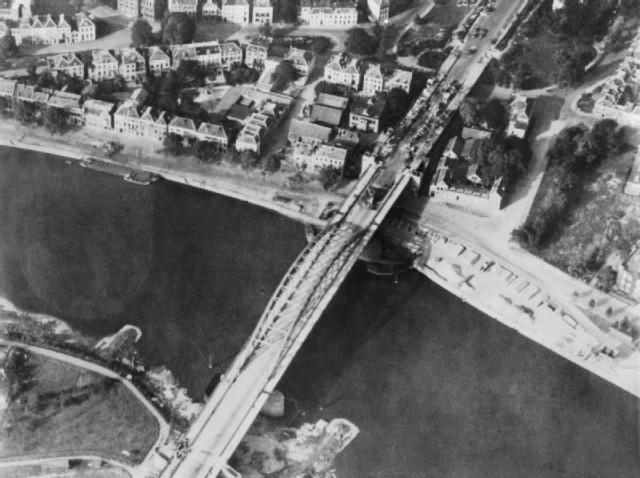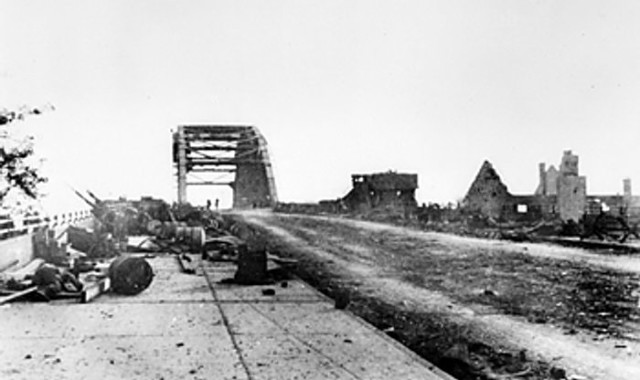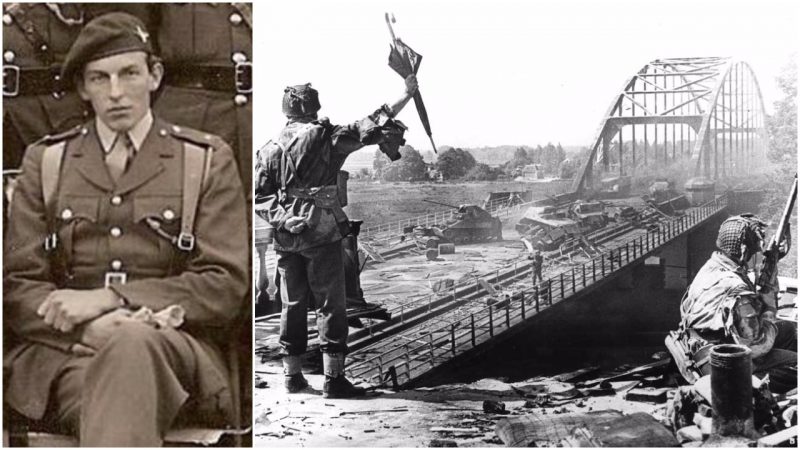One might think that being surrounded by the German SS is no laughing matter, but don’t tell that to British Major Digby Tatham-Warter. This cool Airborne officer used classic British grit and wit to fight off the German onslaught against overwhelming odds and encourage the fighting spirit of his paratroopers until they had fired their last round during the failed attempt to hold the bridge at Arnhem during Operation Market Garden.
Perhaps, what is more remarkable, is that this man did so with a rolled up umbrella in hand. In fact, by some accounts he actually disabled a German tank by thrusting the umbrella through the observations slit and wounding the driver. By another account, when the battalion chaplain was pinned down by mortar fire, he walked over and opened the umbrella as if to give him cover from the destruction and escorted him through the enemy fire.
His is a story almost too inexplicable to be true, but fact is indeed stranger than fiction when it comes to Major Digby Tatham-Warter.
A Taste for War
Digby was born in 1917 to a veteran of the first World War. By 1937, he was embarking on his own military career after graduating from Sandhurst Military College. It was initially his desire to join the Indian Army to pursue his passions of tiger hunting, pig-sticking, and all the general exploits of a wild Safari one might enjoy.
He joined the 2nd Battalion Oxfordshire and Buckinghamshire Light Infantry in 1938 in India where he would miss out on the bulk of the fighting during the early years of the war.
However, he subsequently transferred to the Parachute Regiment and was made the commander of A Company of the 2nd Parachute Brigade just as they were wrapping up their fighting in Italy.

However, his reputation as a calm and cool commander with a knack for innovation and aggression would place him in one of the most famed battles of the latter part of World War II. Operation Market Garden was General Montgomery’s attempt in late 1944 to secure a bridgehead over the river Rhine in the Netherlands.
To achieve this feat, it would require the largest paratrooper airborne assault in history behind enemy lines that would be supported by rapidly advancing armor. The job of the paratroopers would be to secure these vital bridges and hold out until the armor arrived.
Digby would state that he carried the umbrella because he always had trouble remembering the passwords after a drop and he thought few could mistake the man carrying an umbrella in the middle of a war is anything but inexplicably British. However, it served a dual purpose of providing a little British wit and humor to what would otherwise be a very serious affair.
But unconventional was Digby’s nature. While training in England, he became convinced that the radios were unreliable and trained his men on the use of bugle calls from the Napoleonic Wars to communicate with one another. And as odd as it may sound, both the bugle and the umbrella would come in quite handy.
The Chaos After the Jump
The failure to secure the bridge at Arnhem can be blamed on many shortcomings, none of which could be attributed to Digby and his beloved A company. With speed, bugle calls, and yes the umbrella, Digby led his company to the bridge as planned.
Much as he anticipated, the radios were not functioning and the bugle calls actually allowed Digby to continue his rapid advance to their objective bypassing German armor in the city streets. Once in position, Digby and his men dug in and waited for the cavalry to arrive.
The problem was that the rest of the invasion forces had not fared as well. The armor was held up due to vicious German resistance and the rest of the landing paratrooper forces had failed to achieve all of the necessary objectives to ensure the rapid advance.
As a result, Digby and the rest of the Battalion led by Lt. Colonel Frost were at the mercy of German counter-attacks as they slowly but surely ran short of food, water, and eventually ammunition. But fighting spirit was still in good supply as the British paratroopers held out for three days and four nights.
At one point as the SS 9th, Panzer Division seemed to push successfully across the bridge, Digby personally led a bayonet charge with a pistol in one hand while wildly swinging the umbrella over his head with the other and successfully drove back the German attack.

Out of ammunition and cut off from the rest of the Allied forces, Digby and most of what remained of his men were surrendered. Having been wounded, Digby was sent to a local hospital upon being captured where he eventually escaped out of the window with a fellow officer.
Exhausted, hungry, and dehydrated, they eventually found their way to a farmhouse for refuge where he would be put in contact with the Dutch resistance. And just as inexplicable as his war experience had been, Digby had a little bit more bizarre up his sleeve.
The Dutch Resistance
As it turns out, there were between 100 to 200 allied paratroopers hiding out in the region with the help of the resistance. This placed a heavy burden on the resistance resources and a command for these men was eventually set up by Digby.
And in order to communicate with his men strewn throughout the region, he would travel as only a man like Digby could, on a bike, in broad daylight, in front of the Germans and for all to see. As it turns out, his cool and calm demeanor that served him well in battle was an asset that allowed him to travel amongst the region as if he belonged with the help of some forged documents and civilian clothing. And the Germans believed it.
In fact, more than just believe it, he actually pulled over to help push a German staff officer car out of a ditch with the Germans none the wiser.
And while the initial plan was for these men to wreak havoc on the Germans from behind the lines, that plan was eventually scuttled, and Digby would lead 138 men west towards the allied lines. On October 22nd, just one month after he had surrendered, Digby led his men through the German lines and to safety in what was dubbed Operation Pegasus.
Whether it was the umbrella, bugle calls, or his ability to ride a bicycle right past German troops, this story is too inexplicable to be left out of the halls of history.
Just ask the German tank crew member who got poked in the head by a mad British man wielding an umbrella.
